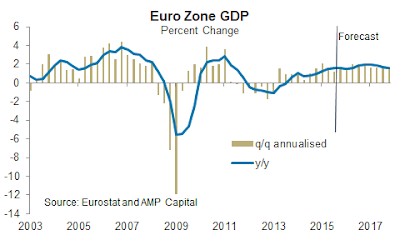[Economic Insights] Growth and monetary policy in Japan and the Eurozone
2 views
Skip to first unread message
Bevan Graham
Nov 16, 2015, 3:55:00 PM11/16/15
to worldview...@googlegroups.com
Third quarter growth was weaker than
expected in both Japan and the Eurozone.
Further monetary easing appears inevitable in both cases. This will, in turn, have implications for the
extent to which the Fed can take its foot of the monetary policy accelerator.
Eurozone GDP expanded 0.3% in the third
quarter of 2015, below the consensus expectation of +0.4%. Annual growth came in at +1.6%, up from +1.5%
in the second quarter. France and
Germany both posted growth of +0.3% over the quarter with Italy disappointing
at +0.2%. Spain continues to expand more
rapidly with a +0.8% increase over the quarter, though off a lower base.
Breakdowns of growth into its core demand
components are not yet available but partial data for the quarter suggest the
detail will show reasonably solid consumption growth offset by weakness in
capital spending and net exports.
We see little scope for growth to
accelerate from the current 1.6% annual pace in the near-term. As we’ve said all year, the likely pace of
growth is unlikely to prove sufficiently fast to put any sustained upward
pressure on inflation. While core
Eurozone inflation is off its lows, it remains stuck at around 1.0%, well shy
of the ECB’s 2.0% target.
ECB President Mario Draghi recently stated
that “signs of a sustained turnaround in core inflation have somewhat weakened”
and that the bank’s monetary policy stance will be re-evaluated at its December
meeting. That along with the downside
risks to growth in the Eurozone key trading partners seems to make further
easing a done deal.
Turning to Japan, the economy entered its
second (technical) recession in 18 months.
The first came in the aftermath of the consumption tax increase last
year, making this more recent downturn more worrying in that it highlights the
fundamental weakness of the economy.
GDP contracted at an annualised rate of
-0.8% in the September quarter, well below the market consensus of -0.2%. The biggest disappointment was the drop in
capital spending which contracted at an annual rate of 5.0% over the
quarter. Strong capital spending growth observed
in the in the first quarter of the year has now been completely unwound. That’s inconsistent with recently upbeat capital
spending intentions from various business surveys with concerns about the
domestic economy and more recently China resulting in those intentions being
delayed.
Consumer spending was solid at an
annualised pace of +2.1% and net exports were positive, the first positive
contribution in three quarters. Weaker
inventories was the major downside surprise, although that provides some scope
for a recovery in production further down the track.
Looking ahead we think capital spending
will remain soft and exports appear likely to slow. Furthermore the positive impact from the last
supplementary budget is now beginning to fade.
That leaves consumer spending as the determining factor of the pace of
growth from here. So it seems inevitable
here too that the central bank will be forced to step up its monetary easing.
One of our “Themes for 2015” was the
emergence of divergent monetary policy settings amongst the G4, with the US and
the UK the first to tighten with more easing likely in the Euro zone and
Japan. While expectations of UK tightening
are now pushed out well into 2016, our base case is the Fed hikes in
December. That means we can stop
fretting about the timing of lift-off and start worrying about what really
matters – the pace and extent of the tightening – which we expect to be gradual. One of the key limiting factors on US interest
rate increases will be the strong likelihood of further easing in Europe and
Japan and upside implications for the USD.
--
Posted By Bevan Graham to Economic Insights at 11/17/2015 09:54:00 AM
Reply all
Reply to author
Forward
0 new messages


